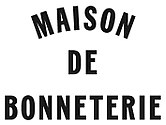Maison de Bonneterie
| Maison de Bonneterie
|
|
|---|---|
| legal form | |
| founding | 1888 |
| resolution | 2014 |
| Seat | Amsterdam and The Hague |
| Number of employees | up to 200 |
| Branch | Fashion, textile trade |
| Website | http://maisondebonneterie.blogspot.de/ |
Maison de Bonneterie ( House of Hosiery ) was a small but well-known Dutch chain of fashion stores with branches in Amsterdam , The Hague , Laren , Heemstede u. a. It was founded in Amsterdam in 1888 and closed on August 24, 2014. The name was retained until the end, although the stores had turned into fashion department stores by the early twentieth century. The buildings in Amsterdam and The Hague are listed buildings .
1888: Founding and development by Joseph Cohen & Rosa Wittgenstein-Cohen
In 1887 Joseph Cohen (1860–1924), son of a textile merchant from Dinslaken , moved to Amsterdam. There he met Rosa Wittgenstein (1867–1949) from Warburg , who worked in the Hirsch & Cie fashion department store . She was a niece of the department store founder Sally Berg . In 1888 Joseph Cohen and Rosa Wittgenstein rented their own shop at Kalverstraat 181, at the corner of Olieslagersteeg, and opened a small textile shop for wool and hosiery there the following year, which they called "Maison de Bonneterie". A few months later she married in Rosa's native town of Warburg and opened the first branch of her business there. Further branches followed in The Hague (1895), Rotterdam , Laren and Heemstede .
As the rooms of the parent company in the Kalverstraat quickly became too small, the neighboring houses Kalverstraat 179 and Olieslagersteeg 6 up to the Rokin were acquired in 1893. In 1901 Queen Wilhelmina granted the business the title purveyor to the court . A few years later, the old buildings were demolished and a modern department store with large shop windows and a magnificent glass dome was built on the property, which opened in 1909. Architects were Albert Jacot and Willem Oldewelt. The building has been a listed building since 1974. In 1913 Jacot built a large department store, which is now also under monument protection, for the shop in The Hague, Gravenstraat 2, including the neighboring property No. 4.
1921: Alfred & Max Cohen
In 1921, Joseph and Rosa Cohen, who had no children, transferred the business to two of Joseph's cousins, Alfred and Max Cohen. Joseph died in 1924, but his wife Rosa was still involved in the background. In 1937 she was made a knight in the Order of Orange-Nassau . For the 50th anniversary in 1939, the management gave its employees a bonus, in return the company's employees donated four glass windows for the stairwell.
After the invasion of the Netherlands , all companies with Jewish management were instructed to report by November 30, 1941. Alfred and Max Cohen had to give up their property rights, but initially remained directors until German administrators were appointed. Alfred's son Leo, who happened to be on a business trip while in the United States, joined the Dutch Army and changed his name to Colland. In January 1942, the Cohen family was assured safe conduct to Portugal if they gave up their Amsterdam property, including their collection of paintings. They emigrated to the USA. Because of the war, all shops were finally closed, some of them looted and used as storage rooms for textile imports. 66 of the Jewish employees perished in German concentration camps during the war . After the war, memorial plaques were erected for them in department stores in Amsterdam and The Hague and they are commemorated annually.
The expropriations were reversed after the war. However, Alfred and Max Cohen stayed in the USA, managed the business from there and appointed David von Dijk from New England as assistant to the management. Rosa Cohen-Wittgenstein returned to Amsterdam and died there in 1949 at the age of 81.
1951: Leo Colland, Paul Herz et al
In 1951 Alfred's son Leo, who was a great fur expert, became managing directors together with Paul Herz. Extensive restructuring and modernization were undertaken to adapt the business to the changed requirements. In 1956, Paul Herz died prematurely and his position was taken over by his wife, Ellen David. After the shop-in-shop system, collaborations with other fashion houses such as Ralph Lauren , Burberry , Hugo Boss , Strenesse , Dolce & Gabbana , Max Mara , Replay , Sergio Rossi , Tommy Hilfiger , Diesel , Armani , Donna Karan and Gant have followed since the 80s .
1985: Jim Colland & Willem Koster
In 1985, Leo's son Jim Colland, who had already been in the business since 1982, and Willem Koster, son of Paul Herz, took over the management. In 1989 the centenary of the house was celebrated with great effort. Eight well-known artists created lithographs for this , which were sold for the benefit of UNICEF . In the same year, the Rotterdam location at Lijnbaan 83 had to close for economic reasons. In 2011 the Laren location was taken over by the New York fashion chain McGregor .
2014: closure
In 2014, the main stores in Amsterdam and The Hague were taken over by the Swedish textile company Hennes & Mauritz and reopened the following year. The buildings remained in the family-owned real estate company " Maison de Bonneterie Immobilien BV ". In 2016, the renovation of the The Hague building won the city's Monument award.
literature
- Marja Berk: Glinsteringen , De Arbeiderspers , Amsterdam 1989, ISBN 90-295-0238-X , ISBN 978-90-295-0238-2







